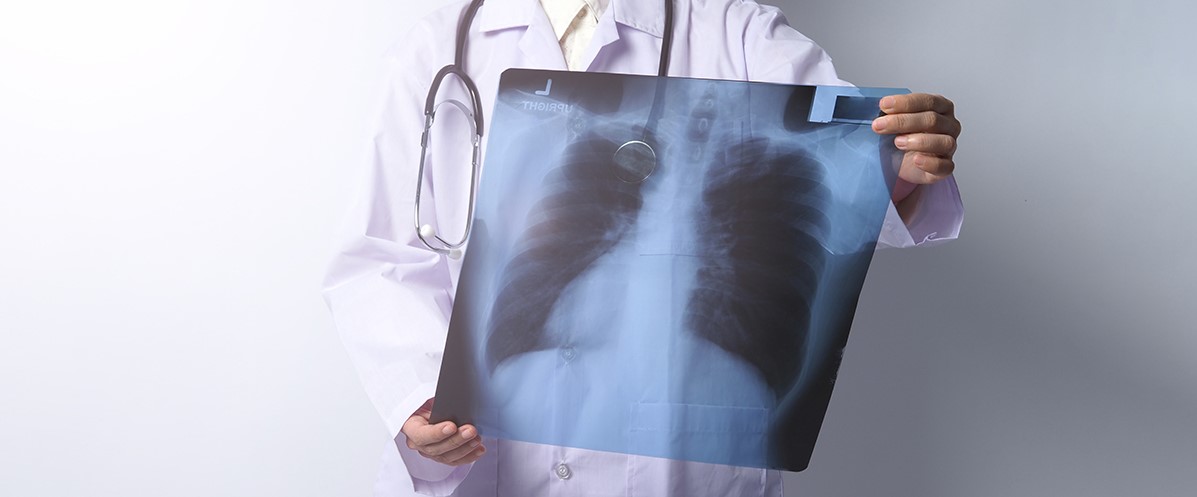Chest diseases
This branch of medicine is responsible for diagnosing and treating lung and respiratory system diseases. The main areas of focus include:
Main Interests
✔ Asthma
✔ Tuberculosis
✔Bronchitis
✔Pneumonia
✔ Emphysema
✔ Lung cancer

Asthma
Asthma: is a respiratory disease caused by various factors that lead to the narrowing, inflammation, or blockage of the airways with thick mucus-like substances such as phlegm. While the exact cause is unknown, genetics are believed to play a role. Asthma is not contagious and can occur at any age. It sometimes causes wheezing, shortness of breath, and coughing. When asthma symptoms suddenly become severe, it is called an asthma attack. In this case, the patient experiences severe breathing difficulty. Treatment involves medication to prevent or stop asthma attacks, along with preventive measures, and sometimes vaccination.
Tuberculosis
TB is a contagious disease caused by a microbe called the TB bacillus. While it primarily affects the lungs, it can also spread to other parts of the body through the bloodstream.
TB is transmitted through the respiratory system from active TB-infected individuals. Proper nutrition and clean air are essential for treatment. After diagnosis, patients are treated with medications, especially antibiotics, for at least six months.
Bronchitis
Bronchitis is the inflammation of the lower respiratory tract due to irritation of the airway lining. Acute bronchitis, usually caused by viruses or irritating substances, is typically mild and fully recoverable. Common causes include viruses and bacteria. Harmful respiratory factors like air pollution, smoking, and secondhand smoke can also cause the disease, which is more common in cold weather. Initial symptoms of acute bronchitis include a dry and painful cough, followed by phlegm. Additional symptoms may include runny nose, chills, mild fever, fatigue, sore throat, phlegm, thirst, dry and white tongue.
Acute Bronchitis
Acute bronchitis, which is a common disease, is an inflammation caused by viruses or items that is irritants of the airways, which mostly progress slightly and completely heal.
The main cause is viruses and bacteria. Factors that damage the respiratory tract such as air pollution, chimney, and cigarette smoke pave the way for the emergence of the disease. It is more common in cold weather.
The first symptom of acute bronchitis is a dry and painful cough Later, expectoration is seen. A runny nose, tremors, febricula, and malaise are also among the symptoms of the disease.
Chronic Bronchitis
Chronic bronchitis starts quietly and progresses slowly, leading to airway narrowing over time, resulting in acute respiratory failure. The most common symptoms are a long-lasting dry cough and excessive phlegm production, persisting for at least three months for two consecutive years. Breathing becomes difficult due to airway constriction. Smoking is the primary cause of this disease, but air pollution, alcohol consumption, and poor nutrition also contribute.
Pneumonia
Pneumonia is a serious lung disease characterized by pain, high fever, and coughing. The disease manifests as inflammation in both lungs, caused by microorganisms such as viruses, bacteria, or fungi. Common symptoms include fatigue, high fever, and coughing.
Additionally, there may be symptoms like loss of appetite, weight loss, confusion, dizziness, severe headache, sore throat, phlegm, extreme thirst, dry and white tongue. Types of pneumonia include:
Types of Pneumonia:
Lobar Pneumonia:
Caused by microorganisms called pneumococci, it can result from excessive fatigue, exposure to cold, or prolonged sun exposure. It occurs suddenly with symptoms like headaches, chills, vomiting, back pain. Fever can reach up to 40 degrees Celsius. The cough is short, and the phlegm is bloody and viscous. The patient’s face turns red, the area around the lips swells, the skin becomes dry, and the tongue darkens.
Virus Pneumonia
This type of pneumonia is an infection in the lungs caused by viruses. It can occur after a common cold or suddenly. The patient feels extreme fatigue, and the cough is usually dry without phlegm.
Bronchopneumonia:
This type of pneumonia develops due to inadequate treatment of diseases such as the flu, whooping cough, bronchitis, or measles. It results from inflammation in the lungs and bronchial tubes. Initially, the disease resembles bronchitis, but if necessary, precautions are not taken, it becomes severe within 2-3 days, producing inflammatory and bloody phlegm when coughing.
Pulmonary Edema (Chronic Obstructive Pulmonary Disease - COPD):
Pulmonary edema, a disease resulting from long-term smoking, causes breathing difficulty. Medication is crucial for treating this disease. However, as the disease progresses, medications may not be sufficient. At this stage, breathing difficulty increases significantly and poses a life-threatening risk. In this case, attempting lung volume reduction surgery is an option.
Lung cancer
Lung cancer occurs when cells in the lungs or bronchial tubes multiply uncontrollably. The most significant factor causing lung cancer is cigarette smoking and similar substances.
Additionally, exposure to materials like asbestos, radon gas, and genetic predisposition can also cause lung cancer. Symptoms do not appear in the early stages of lung cancer.
However, as the cancer grows, symptoms such as coughing, coughing up blood, back pain, weight loss, weakness, hoarseness, and shortness of breath may develop. The success of treatment depends on the stage of the disease. Surgery is performed in the early stages of the disease, which is the most effective way to completely treat it.
Cryosurgery can also be applied to early-diagnosed lung cancers, a method of destroying cancer cells through freezing. Chemotherapy can be added to surgical treatment. If the disease is advanced, chemotherapy and sometimes radiation therapy are performed. If a patient experiences breathing difficulty, but surgery is not suitable, the tumor can be removed by bronchoscopy.
The most important cause of the disease is smoking. Air pollution, alcohol abuse and malnutrition also contribute to the development of the disease.
Chronic bronchitis begins without symptoms and gradually progresses, leading to obstruction in the airways and, as a result, severe respiratory failure.
The most prominent symptom of the disease is a long-term dry cough and excessive sputum that continues for at least 3 months for 2 consecutive years. Dyspnea is experienced because of the restriction of the bronchi. The patient gets tired very easily and becomes short of breath, and his/her breathing is wheezing.
The most important cause of the disease is smoking. Air pollution, alcohol use, and malnutrition also contribute to the progress of the disease.
Diagnostic Methods Used in Chest Diseases
The main methods used in the diagnosis of chest diseases are as follows:
✔ X-ray
✔Ultrasonography
✔ CT (Computed Tomography)
✔MR Imaging
✔Bronchoscopy
✔PET/CT

X-Ray
X-rays are a rapid and painless method used to visualize body structures, especially bones.
X-rays pass through your body; however, they are absorbed and reflected differently depending on the density of the material they pass through.
Bones and metals, which are dense materials, appear white on X-rays. Air in the lungs appears black, while fats and muscles appear as shades of gray.
Ultrasonography
In this method, very high-frequency sound waves that are inaudible to the human ear are used to image organs inside the body. Since different tissues reflect sound waves at different rates, organs and tissues appear in various colors on the ultrasonography device’s screen.
This method can identify abnormal tissues such as cysts or tumors. Doppler ultrasound is used to measure the speed and direction of blood flow in the vessels. Sound waves continue to be sent, but the movement of blood alters the sound frequency, providing information about blood flow. This method can detect problems like vein blockages or narrowing.
CT (Computed Tomography)
In this method, X-rays are used to display the body in cross-sectional slices. X-rays are absorbed and refracted differently by different tissues, creating images with different densities on the CT scan device’s screen.
CT scans provide more detailed information compared to regular X-rays. They are particularly effective in imaging the brain, head traumas, and brain tumors. CT scans can also image bones, soft tissues, and blood vessels.
MR Imaging
Magnetic Resonance Imaging, or MRI, is a radiation-free method for visualizing the body’s internal structure. In this method, the body is placed in a strong magnetic field, and radiofrequency waves are sent.
Since different tissues interact differently with the magnetic field and radiofrequency waves, clear images are obtained on the MRI device’s screen. MRI is particularly successful in imaging soft tissues. It can detect cancerous areas that may not be discoverable through other imaging methods.
Bronchoscopy
Bronchoscopy is a procedure that allows for the examination of the throat, trachea, and bronchial tubes by entering through the throat. A thin tube (endoscope) equipped with light and a camera at its end is used in this method. Thanks to the camera, the inner surface of the bronchial tubes can be seen on the bronchoscopy device’s screen.
Bronchoscopy can be used for both diagnostic and therapeutic purposes. For instance, foreign bodies in the airways can be removed through bronchoscopy. Additionally, benign or malignant tumors that cause breathing difficulties can be removed or reduced via bronchoscopy. In patients with airway narrowing, stents can be inserted through bronchoscopy.
PET / CT
PET/CT (Positron Emission Tomography/Computed Tomography) is one of the most advanced imaging technologies available today. In this method, a radioactive substance is injected into the patient and spreads throughout the body. Cancer cells absorb a larger amount of this substance compared to normal cells and appear as bright spots on the screen of the PET/CT scanner.
Using PET/CT imaging, various types of cancer can be identified, and their stages can be determined. It is also used to monitor cancer progression after treatment and plan for radiation therapy. PET/CT can provide insights into whether cancer cells are benign or malignant and their locations within the body.
